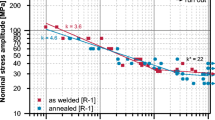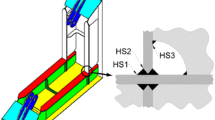Abstract
The lifetime of a welded component is finally influenced by the various service conditions. The stress redistribution effect of subsequent load histories is fundamental to the load-bearing capacity of a structure later in service. Since every welded structure additionally experiences external shrinkage restraint, the resulting structural loads are very important for mechanical assessment. Forward-looking development of materials furthermore requires particular consideration of in-service load histories and of their effects on the global structural loads of a construction under shrinkage restraint. Using a large-scale test facility, stress and residual stress investigations have been performed relating to the subject area of residual stress redistribution resulting from a simulated load history. Based on the presented results, which were all carried out with matching filler materials, further research work concerning the influence of the variation of the mismatch factor on the residual stress distribution has to be done.
Similar content being viewed by others
References
Smith W.J., Kilpatrick I.M.: The measurement and prediction of residual and restraint stresss in submarine structures, Proceedings: Advances in marine structures, Second International Conference, Scotland, 1991, Elsevier Science Publisher Ltd., pp. 733–748.
Baitout F., Bergheau J.M.: The numerical simulation of welding in Europe: Present Capabilities and Future trends. Trans. JWRI, 2003, Vol. 32, No. 1, pp. 197–206.
Satoh K., Ueda Y., Kihara H.: Recent trends of research into restraint stresses and strains in relation to weld cracking, Doc. IIW-425-73 (ex doc. IX-788-72/X-659–72), Welding in the World, 1973, Vol. 11, No. 5/6 pp. 133–156.
Kannengiesser Th., Florian W., Böllinghaus Th., Herold H.: Effect of weld metal strength and welding conditions on reaction forces and stress distribution of restrained components, Doc. IIW-1501-00 (ex doc. IX-1971–00), Welding in the World, 2001, Vol. 45, No. 1/2, pp. 18–26.
Böllinghaus Th., Kannengießer Th.: Effects of filler material selection and shrinkage restraint on stress strain build up in component welds, Trends in Welding Research 2002, Georgia, USA, 6th International Conference, ISBN 0-87170-780–2, pp. 906–911 2002.
Schwarz T., Kockelmann H.: Die Bohrlochmethode-ein für viele Anwendungsbereiche optimales Verfahren zur experimentellen Ermittlung von Eigenspannungen. Messtechnische Briefe 29, Heft 2, 1993, Seite 33–38.
Bhadeshia H.K.D.H.: Material factors, Handbook of Residual Stress and Deformation of Steel, ASM International, pp. 3–10.
Wang J., Chen C., Ding F.: Research on welding stresses during phase transformation. Mechanical effects of welding, IUTAM, Symposium, Int. Union of theoretical and applied physics, Lulea, 1991, pp. 49–56, Springer-Verlag, ISBN 3-540-55240–5.
Author information
Authors and Affiliations
Rights and permissions
About this article
Cite this article
Kannengiesser, T., Boellinghaus, T. & Neuhaus, M. Effects of the Load History on the Residual Stress Distribution in Welded Components. Weld World 50, 11–17 (2006). https://doi.org/10.1007/BF03266531
Published:
Issue Date:
DOI: https://doi.org/10.1007/BF03266531




